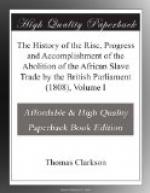The third class, to which I now come, consisted, as we have seen, first, of the Quakers in America; and secondly, of an union of these with others on the same continent. The principal individuals concerned in this union were James Pemberton and Dr. Rush. The former of these, having taken an active part in several of the yearly meetings of his own Society relative to the oppressed Africans, and having been in habits of intimacy and friendship with John Woolman and Anthony Benezet, with the result of whose labours he was acquainted, may be supposed to have become qualified to take a leading station in the promotion of their cause. Dr. Rush also had shown himself, as has appeared, an able advocate, and had even sustained a controversy in their favour. That the two last mentioned acted also on motives of their own, or independently of those belonging to the other two classes, when they formed their association in Pennsylvania, will be obvious from these circumstances; first, that most of those of the first class, who contributed to throw the greatest light and odium upon the Slave-trade, had not then made their public appearance in the world. And, with respect to the second class, the little commitee belonging to it had neither been formed nor thought of.
And as the individuals in each of the three classes, who have now been mentioned, had an education as it were to qualify them for acting together in this great cause, and had moved independently of each other, so it will appear that, by means of circumstances which they themselves had neither foreseen nor contrived, a junction between them was rendered easily practicable, and that it was beginning to take place at the period assigned.
To show this, I must first remind the reader that Anthony Benezet, as soon as he heard of the result of the case of Somerset, opened a correspondence with Granville Sharp, which was kept up to the encouragement of both. In the year 1774, when he learned that William Dillwyn was going to England, he gave him letters to that gentleman. Thus one of the most conspicuous of the second class was introduced, accidentally as it were, to one of the most conspicuous of the first. In the year 1775 William Dillwyn went back to America, but, on his return to England to settle, he renewed his visits to Granville Sharp. Thus the connection was continued. To these observations I may now add; that Samuel Hoare, of the same class as William Dillwyn, had, in consequence of the Bishop of Chester’s sermon, begun a correspondence in 1784, as before mentioned, with Mr. Ramsay, who was of the same class as Mr. Sharp. Thus four individuals of the two first classes were in the way of an union with one another.




